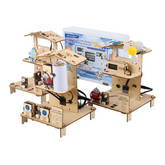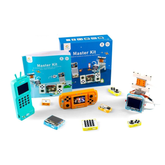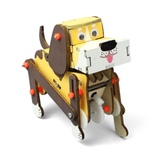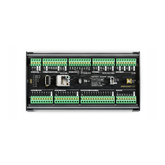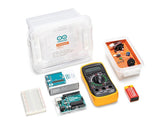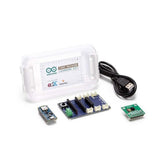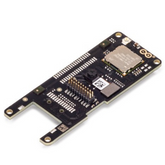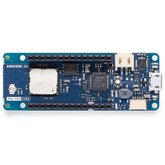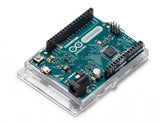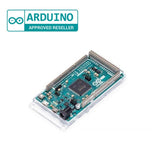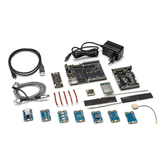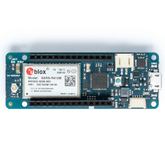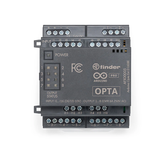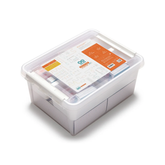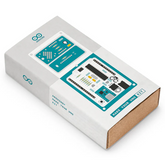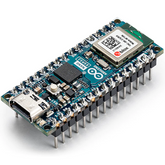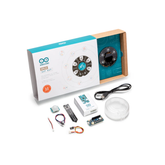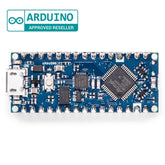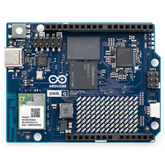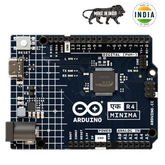-
Official Arduino Portenta Machine Control Unit - AKX00032Official Arduino Portenta Machine Control Unit The Official Arduino Portenta Machine Control Unit is an advanced, centralized industrial controller designed for modern factory automation and smart manufacturing. Built around the powerful Portenta H7 microcontroller (included), it offers exceptional computing capabilities for predictive maintenance, AI-driven...
- Rs. 28,569
Rs. 49,499- Rs. 28,569
- Unit price
- per
Save Rs. 20,930 -
Arduino Student KitArduino Student Kit The Arduino Student Kit is divided into nine step-by-step lessons and two open-ended group projects. The kit contains boards, a collection of sensors and actuators, and access to an online platform, with extra content including invention spotlights, concepts, and interesting facts...
- Rs. 5,999
Rs. 12,999- Rs. 5,999
- Unit price
- per
Save Rs. 7,000 -
Arduino Tiny Machine Learning KitArduino Tiny Machine Learning Kit The Arduino Tiny Machine Learning Kit is the perfect arduino kit to start and accelerate your journey in the new and upcoming domain of Tiny Machine Learning. The Arduino BLE Sense Lite board comes with a lot of interesting onboard sensors...
- Rs. 5,352
Rs. 7,499- Rs. 5,352
- Unit price
- per
Save Rs. 2,147 -
Official Arduino Portenta Vision Shield with LORA Connectivity - ASX00026Official Arduino Portenta Vision Shield with LORA Connectivity The Official Arduino Portenta Vision Shield with LoRa Connectivity is an advanced hardware extension designed for the Arduino Portenta family, specifically the Portenta H7. This shield enables powerful edge AI applications by combining embedded computer vision...
- Rs. 7,149
Rs. 9,999- Rs. 7,149
- Unit price
- per
Save Rs. 2,850 -
Official Arduino MKR WAN 1310 Development Board - ABX00029Official Arduino MKR WAN 1310 Development Board The Official Arduino MKR WAN 1310 is an open-source development board designed to bring reliable and energy-efficient LoRa connectivity to your IoT projects. Ideal for applications requiring low power consumption, this board integrates the powerful Arm Cortex-M0...
- Rs. 3,499
Rs. 6,499- Rs. 3,499
- Unit price
- per
Save Rs. 3,000 -
Arduino Leonardo with HeadersArduino Leonardo with Headers The Original Arduino Leonardo is a microcontroller board based on the ATmega32u4. It has 20 digital input/output pins (of which 7 can be used as PWM outputs and 12 as analog inputs), a 16 MHz crystal oscillator, a micro USB...
- Rs. 1,799
Rs. 2,499- Rs. 1,799
- Unit price
- per
Save Rs. 700 -
Arduino Uno R3 OriginalArduino UNO R3 Original The Arduino Uno R3 is a microcontroller board based on the ATmega328P chip. This board has 14 digital I/O pins (6 support PWM), 6 analog inputs, a 16 MHz crystal resonator, a USB connector, a power jack, an ICSP header,...
- Rs. 1,749
Rs. 2,649- Rs. 1,749
- Unit price
- per
Save Rs. 900 -
Original Arduino Mega 2560 ATmega2560 Rev3Original Arduino Mega 2560 ATmega2560 Rev3 This is an Original Arduino Mega board from Arduino Officials based on ATmega16U2. This Arduino development board is based on the ATmega2560 microcontroller. The Arduino Mega has 54 digital input/output pins (of which 14 can be used as PWM...
- Rs. 2,999
Rs. 4,449- Rs. 2,999
- Unit price
- per
Save Rs. 1,450 -
Arduino Due Original A000062Arduino Due Board Original A000062 Introducing the Arduino Due Original, the groundbreaking microcontroller board based on the Atmel SAM3X8E ARM Cortex-M3 CPU. This board is the first Arduino with a 32-bit ARM core microcontroller, unlocking a new level of performance and capabilities for your...
- Rs. 3,639
Rs. 4,999- Rs. 3,639
- Unit price
- per
Save Rs. 1,360 -
Official Arduino Portenta Proto Kit ME for Advanced Prototyping - AKX00073Official Arduino Portenta Proto Kit ME for Advanced Prototyping The Official Arduino Portenta Proto Kit ME is an all-in-one prototyping solution designed for professionals aiming to build advanced motion-centric IoT applications. It also serves as an excellent STEM kit for advanced learners and educators...
- Rs. 29,653
Rs. 49,999- Rs. 29,653
- Unit price
- per
Save Rs. 20,346 -
Official Arduino MKR NB 1500 GSM Board - ABX00019Official Arduino MKR NB 1500 GSM Board The Official Arduino MKR NB 1500 Board is a powerful IoT development platform designed to enable wireless connectivity using Narrowband IoT (NB-IoT) technology. Utilizing existing LTE cellular infrastructure, NB-IoT provides faster, and more energy-efficient communication compared to...
- Rs. 6,869
Rs. 9,999- Rs. 6,869
- Unit price
- per
Save Rs. 3,130 -
Official Arduino Pro Opta Ext D1608E Expansion Board - AFX00005Official Arduino Pro Opta Ext D1608E Expansion Board The Official Arduino Pro Opta Ext D1608E is a powerful expansion module designed to elevate the capabilities of your Arduino Opta. It adds 16 programmable voltage inputs and 8 electromechanical relays (250 VAC, 6A), enabling robust...
- Rs. 12,399
Rs. 19,999- Rs. 12,399
- Unit price
- per
Save Rs. 7,600 -
Arduino Education Starter KitArduino Education Starter Kit The Arduino Education Starter Kit offers a comprehensive package of hardware and software necessary for eight students, grouped in pairs. It encompasses step-by-step lessons, teacher notes, exercises, and an array of additional optional resources such as activities, concepts, history, and...
- Rs. 23,999
Rs. 29,999- Rs. 23,999
- Unit price
- per
Save Rs. 6,000 -
Official Arduino make your Uno KitOfficial Arduino make your Uno Kit The Arduino Make Your UNO Kit offers a unique, hands-on experience for learning the fundamentals of electronics and soldering by guiding you through the assembly of your very own Arduino UNO board. This comprehensive Arduino kit includes all...
- Rs. 4,899
Rs. 7,999- Rs. 4,899
- Unit price
- per
Save Rs. 3,100 -
Arduino NANO ESP32 with Headers - ABX00083Arduino NANO ESP32 with Headers The Arduino Nano ESP32 is a game-changing addition to the Arduino family, providing access to MicroPython and Arduino programming via the popular ESP32-S3. This board is a wonderful resource for people at all stages of their journey, whether they...
- Rs. 1,646
Rs. 2,249- Rs. 1,646
- Unit price
- per
Save Rs. 603 -
Arduino Opla IoT Kit AKX00026Arduino Opla IoT Kit AKX00026 The Arduino Opla IoT Kit is perfect if you're looking to add smart connectivity to your home or workplace devices. With this IoT kit, you’ll learn how to turn everyday appliances into smart devices that you can control straight...
- Rs. 12,399
Rs. 16,499- Rs. 12,399
- Unit price
- per
Save Rs. 4,100 -
Official Arduino Pro 4G GNSS Module Global - TPX00200Official Arduino Pro 4G GNSS Module Global The Arduino Pro 4G GNSS Module Global is a cutting-edge solution designed to significantly expand the connectivity capabilities of your Arduino Portenta projects, allowing you to unlock their full potential without needing to change the main board....
- Rs. 6,194
Rs. 8,249- Rs. 6,194
- Unit price
- per
Save Rs. 2,055 -
Arduino Nano Every with Headers ABX00033Arduino Nano Every with Headers ABX00033 The Arduino Nano Every is an evolution of the traditional Arduino Nano board but features ATMega4809 which is a more powerful processor. This will allow you to make larger programs than with the Arduino Uno (it has 50% more program...
- Rs. 1,099
Rs. 1,949- Rs. 1,099
- Unit price
- per
Save Rs. 850 -
Official Arduino UNO Q SBC ABX00162Official Arduino UNO Q SBC ABX00162 (PRE-ORDER) The Official Arduino UNO Q is a versatile single board computer designed for makers, developers, and innovators. Its hybrid architecture combines a Linux® Debian-capable Qualcomm® Dragonwing™ QRB2210 microprocessor with a real-time STM32U585 microcontroller, giving you the flexibility...
- Rs. 4,649
Rs. 5,299- Rs. 4,649
- Unit price
- per
Save Rs. 650 -
Original Arduino UNO EK (एक) R4 Minima - Made in IndiaOriginal Arduino UNO EK (एक) R4 Minima - Made in India The Arduino Uno R4 Minima, proudly Made in India, is an innovative 32-bit microcontroller development board. Equipped with the Renesas R7FA4M1AB3CFM microcontroller and a 48 MHz Arm Cortex-M4 processor, it delivers a significant...
- Rs. 699
Rs. 869- Rs. 699
- Unit price
- per
Save Rs. 170

Best Price Guarantee

Ready Stock for Bulk Purchase

Dedicated Account Managers

5% GST Benefits for Eligible SEZ and Edu

Technical Support Available

1-Year Manufacturer Warranty



